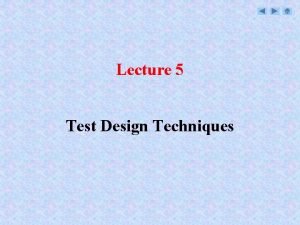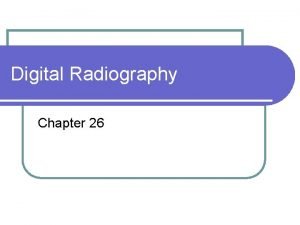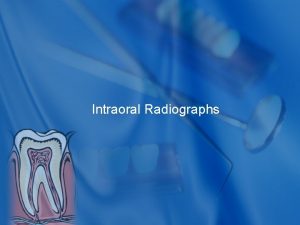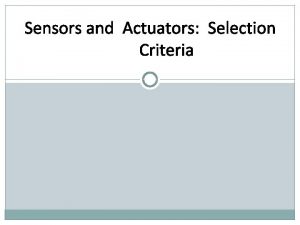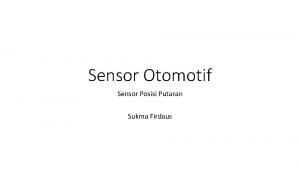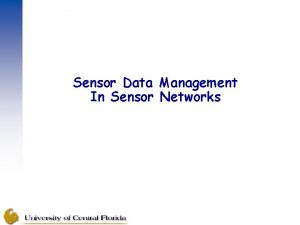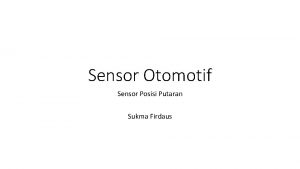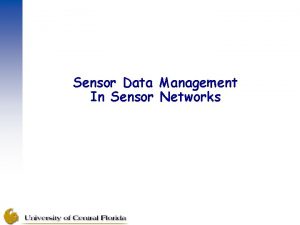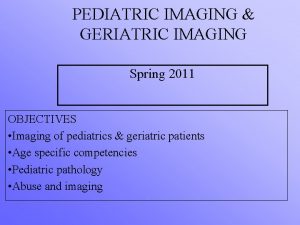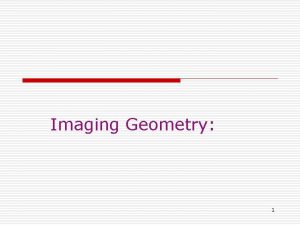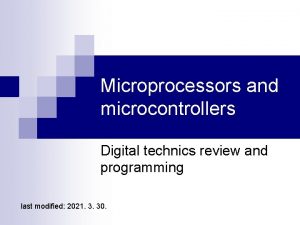CPD and other imaging technics for gas sensor































- Slides: 31

CPD and other imaging technics for gas sensor Budapest University of Technology and Economics, Department of Electron Devices Mizsei, János 18 -28/05/2006 Ustron

Outline • Introduction: potentials in general • Ideal (static) voltmeter. Do we really need contacts ? • What is it for ? Applications. . . • …extension of the application (x-y scanning, higher resolution, (Kelvin Force microscopy) etc. . . • Summary

Introduction: the potential • working ability of a point charge in r • the electric field: force on the charge • it is a general „boundary condition” in the electronics • electrochemical potential: • advantages: it can be easily measured in a broad range, • excellent for characterisation of physical systems:

VOLTMETERS • ”Handy” voltmeters: 20 MW • Electrometers: 1012 -14 (? ) (electron tubes, FET) • Compensation: voltage measurements without current • …without current. Do we really need contacts ?

The ideal VOLTMETER: Rin=¥ How can we do that in practice? Capacitive coupling + compensation: „Vibrating reed voltmeter”

”Vibrating reed” voltmeter: • static capacitive coupling: it is not applicable to transfer the information about DC voltage (except: MOS FET) • solution: non-static (vibrating) capacitor He Phase sensitive R=¥ frquency selective current detector

What else? Potential directly from the surface, without contact. Phase sensitive frequency selective current detector

The CPD: Lower work function (electron emission, positive surface charge) A B Higher work function (negative charge on the surface CPD compensated: zero electric field between the plates !

Capacitance: Charge: Current to be detected:

Up to date equipment: • frequency selective amplifying, phase sensitive (multiply) demodulation • feedback of the DC voltage (automatic compensation) • optical excitation for surface photovoltage measurements • digital realisation • second harmonics detection and feedback for distance control • surface mapping (x-y scan).

The “ideal” energy diagram of a vibrating capacitor - semiconductor system dark (equilibrium) light (non-equilibrium) Ideal: no surface traps around the Fermi-level, the surface index S=1

Additional light excitation: FB state Gas sensor layer

Vibrating capacitor (Kelvin) and SPV (surface photovoltage) method

Kelvin Force Microscopy: AFM + Kelvin Vcpd V Vibration due to voltage on the tip: …stops when !!!

Semiconductors in gas sensitive structures

Behaviour of the semiconductor gas sensor materials Dc Experimentally observed change in the work function and change in the resistance (logarithmic scale) as function of partial pressure (root scale)

Behaviour of the semiconductor gas sensor materials Experimentally observed correlation between the work function DVK and change in the resistance (logarithmic scale, which shows DVR linearly)

Potential shift (change in the CPD) due to chemical signal: • dipole adsorption on the semiconductor surface • dipole adsorption on the reference electrode • charged particles (ions) on the semiconductor surface • change in the bulk defect (donor, acceptor) concentration due to diffusion of the adsorbed atoms • change in the composition (stoichiometry) of the semiconductor materials

Semiconductor resistance/conductance response due to chemical signal: • dipole adsorption on the semiconductor surface • charged particles (ions) on the semiconductor surface • change in the bulk defect (donor, acceptor) concentration due to diffusion of the adsorbed atoms • change in the composition (stoichiometry) of the semiconductor materials • dipole adsorption on the reference electrode • NO • YES, if the surface charge is balanced by the space charge layer in the semiconductor • YES, usually at higher temperature • NO

Non-ideal system Large number of surface traps: Fermi-level pinning, the surface index S<1 Charged particles (ions) on the semiconductor surface: counterpart of the charge is localized to the surface charged particles form dipole layer: CPD response: YES potential barrier, space charge, resistance response: NO (usually at lower temperature)

Activated semiconductor gas sensor surface High number of Qss no conductivity response. Change of the charge in the surface/interface states (Qss) instead of the space charge layer in the semiconductor.

Chemical pictures by vibrating capacitor ALE Sn. O 2 layers: CPD and resistance maps 33 K 30 K 46 K 107 1011 34 K 48 K 133 K 1012 46 K 71 K 1012 97 K 107 1011 1012 1011 182 K 108 1012 1011 200 432 213 145 181 157 146 331 172 140 10 M 156 184 4 M 182

Selective chemical sensing with potential mapping Pd Ag Au Pt 460 K 360 K V Pt Sn. O 2 Temperature gradient Material gradient

Chemical pictures (surface: Pd-Ag-Au-Pt-V-Pt-Sn. O 2) 30 mm 460 K Volt 25 mm C Volt 360 K Pixel 1% H 2 –in air Pd Ag Au Pt NH 4 OH vapour (NH 3) V Pt Sn. O 2 CHCl 3 vapour Pixel C 2 H 5 OH vapour

Porous silicon-p+Si as gas sensor material Light excitation Extremely high amount of + charge in the porous Si

The charge balance: from vibrating capacitor (darklight) or from the SPV (the saturated SPV signal is proportional with the potential barrier)

Kelvin maps - = inversion P+ 0. 015 ohmcm Si 10 100 20 200 50 500 Process time/s in 1. 5/3. 5 HF/C 2 H 5 OH mixture with 50 m. A/cm 2 current density (growth rate is ~0. 07 -0. 1 micron/s) SPV map

Surface conditions: thick and ultrathin oxide covered Si QSS>0 V Y Y V Porous silicon on p+: (strong) depletion

Atomic Force and Kelvin Force Microscopy: charged surface 700000 V/m 700000 V/ m Atomic Force: oxide step Kelvin Force: surface potential

AFM and Kelvin Force Microscopy Morphology Semiconductor (WO 3) gas sensor nanograins potential distribution

Summary • Vibrating capacitor method included the high resolution version (Kelvin Force Microscopy) • Examples: analytical tool and sensor (chemical signal converter) • Conclusion: a lot of useful application possibilities
 State transition testing technique
State transition testing technique Frc control system
Frc control system Gas law
Gas law Difference between ideal gas and real gas
Difference between ideal gas and real gas Self-initiated other-repair examples
Self-initiated other-repair examples Ethics and professional responsibility cpd
Ethics and professional responsibility cpd Princeton imaging and analysis center
Princeton imaging and analysis center Abbe imaging experiment
Abbe imaging experiment Chapter 39 digital imaging film and radiographs
Chapter 39 digital imaging film and radiographs Chapter 39 digital imaging film and radiographs
Chapter 39 digital imaging film and radiographs Derive ideal gas equation
Derive ideal gas equation An ideal gas is an imaginary gas
An ideal gas is an imaginary gas Computational fluid dynamics
Computational fluid dynamics Conclusion on bhopal gas tragedy
Conclusion on bhopal gas tragedy Gas leaked in bhopal gas tragedy
Gas leaked in bhopal gas tragedy Gas reale e gas ideale
Gas reale e gas ideale Flue gas desulfurisation gas filter
Flue gas desulfurisation gas filter Poisonous gas leaked in bhopal gas tragedy
Poisonous gas leaked in bhopal gas tragedy Persamaan arrhenius
Persamaan arrhenius Gas exchange key events in gas exchange
Gas exchange key events in gas exchange Kontinuitetshantering
Kontinuitetshantering Typiska novell drag
Typiska novell drag Nationell inriktning för artificiell intelligens
Nationell inriktning för artificiell intelligens Returpilarna
Returpilarna Varför kallas perioden 1918-1939 för mellankrigstiden?
Varför kallas perioden 1918-1939 för mellankrigstiden? En lathund för arbete med kontinuitetshantering
En lathund för arbete med kontinuitetshantering Kassaregister ideell förening
Kassaregister ideell förening Tidbok yrkesförare
Tidbok yrkesförare Anatomi organ reproduksi
Anatomi organ reproduksi Förklara densitet för barn
Förklara densitet för barn Datorkunskap för nybörjare
Datorkunskap för nybörjare Tack för att ni lyssnade bild
Tack för att ni lyssnade bild
